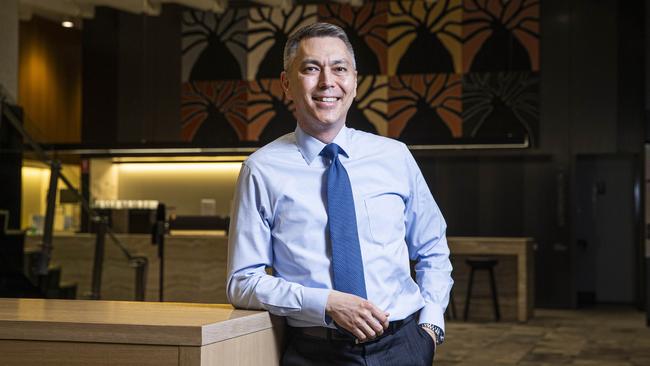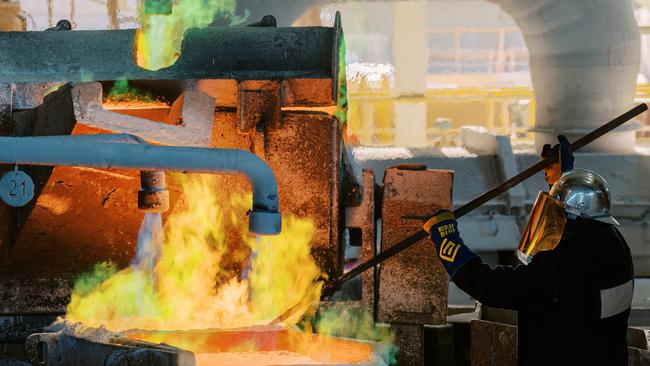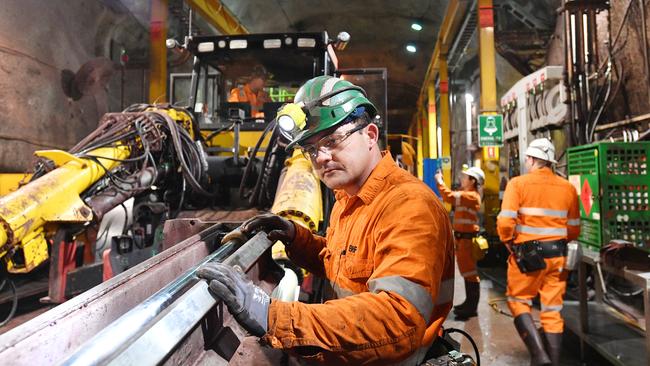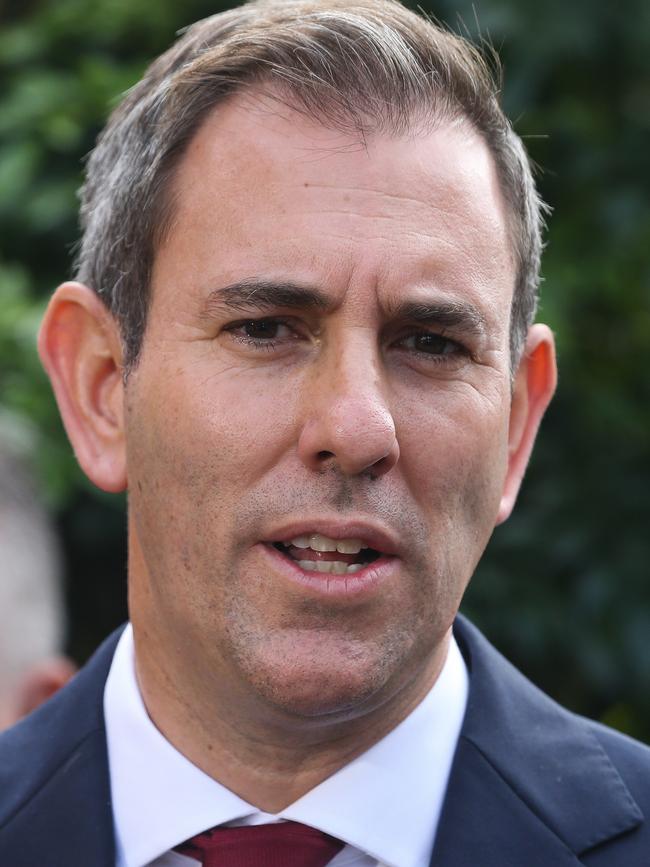BHP CEO Mike Henry readies for next big battle: Productivity
Having secured his $9.6bn Oz Minerals buyout, BHP chief Mike Henry spells out what’s coming next.

Business
Don't miss out on the headlines from Business. Followed categories will be added to My News.
BHP boss Mike Henry has now owned Oz Minerals for just over two weeks and this has given him more confidence around the potential for his $9.6bn acquisition.
As Denver-based Newmont this week was eyeing Newcrest’s copper rich mines as part of its $26bn takeover of the Melbourne-based gold miner, BHP too has big plans for the base metal that is now being touted as the king commodity underpinning the green energy transition.
Speaking to investors in Barcelona, Henry outlined plans for a South Australian copper super hub and issued an aspirational target of producing 500,000 tonnes of the metal a year from the region.

This would combine all the output from Oz’s Prominent Hill and Carrapateena mines with the output from BHP’s giant Olympic Dam copper mine. Collectively they produce around 320,000 tonnes of copper annually, so the aspirational target over time certainly remains that.
Much of the near term uplift is set to come from the $1.25bn block cave expansion of Carrapateena already underway which stands to boost output to 120,000 tonnes, but Henry also kept alive the on again, off again expansion of Olympic Dam.
He also wants to work the current mines harder, using the shared infrastructure between Oz and BHP, which he sees helping to boost productivity.
Indeed productivity was the theme of much of his talk to global investors at the Bank of America Metals and Mining conference with the focus now switching to sweating the high cash producing mining assets harder.
“When we talk about growth inside the company, we always come back to the first and foremost important thing that we need to focus on is running the business that we already have super well and a big part of this is productivity,” he told the conference.
He pointed out that a 10 per cent sustained improvement in BHP’s cost base over time with add between $15-$20bn in value.

“There’s all these other things that of course, we’re focused on doing and looking at where we can create more by the way of greenfield and brownfield potential opportunities to grow … but that has to come in tandem with ensuring that we’re getting maximum value from the capital we already have in the business”.
His comments come amid a backdrop of sagging Australian-wide labour productivity with Treasury recently downgraded its forecasts for labour productivity which has the impact of dampening long term economic growth.
The Oz Minerals acquisition plays into the productivity drive, the BHP boss says. By improving scale and with the right investments, Henry believes BHP will be in a position to create more value from Oz than would have occurred if the copper miner remained as a stand-alone company. He remains cool on lithium largely for that reason – the small nature of the mines means it’s hard to use scale to drive down costs.
The other bets Henry has in play in the near term is hitting 300 million tonnes annually of iron ore output just by running rail and port infrastructure smarter. The iron ore business was designed to run at 240 million tonnes, but is now delivering up to 290 million tonnes. Studies are underway to take this up to 330 million tonnes, which would involve expanding port facilities, Henry says.
The massive Jansen potash project in Canada continues and some time next year will make a decision on moving ahead with stage two expansion even before stage one is up and running.
One sober reminder about when productivity doesn’t work, is through mining accidents. A 25-year-old worker died at the Olympic Dam mine last month and another worker was fatally hit by a train at the Port Hedland iron ore operations in February.
Henry told the conference that while BHP had come a long way on safety in recent years, there were now two workers who had not made it home at the end of the shift. “That really does tell us that we’re not getting the most important basics right,” Henry says.
Bond boom
Despite strains in global money markets and interest rates pushing higher, one corner of the Australian markets is quietly booming.
There’s been a flood of Australian-dollar bond issuance in recent weeks, with billions of dollars sold to investors and more to come as the end of the financial year nears. Since January, Australian bond issuance has topped $115bn, Bloomberg figures show. This is running more than 50 per cent ahead of the same time last year.
A brighter growth outlook in Australia than Europe or North America and growing concerns over the US debt ceiling means global investors are taking another look at the market here. Bond investors generally have a much lower tolerance of risk than share investors, however, are attracted to debt for their predictable income stream.
Australia’s bond market sits well down the global pecking order given the thinner volumes, but the surge in government and bank debt and issues by quality names means the temperature is fast rising.

Bonds issued by Canberra are generating more than three-and-half times the amount of bids, and Friday’s new $700m 2035 line is going to be closely watched.
A team from NSW’s financing agency TCorp is preparing to travel to Japan in coming weeks to meet with fund managers and other investors to highlight the strength of the state’s bond program. While Japanese investors are strong buyers of Australian federal and state government bonds, the TCorp is expected to face questions around whether inflation has peaked and the property market in particular, given that stamp duty is a big driver of state government revenues.
TCorp fired up an already busy semi-government bond market in recent weeks through the issue of a monster bond – a new $2.5bn benchmark 13-year bond. The issue was rushed with bids of more than $3.6bn with the pricing at 4.25 per cent. Some 22 per cent was allocated to offshore investors, the highest level for a large issue in years.
That means NSW has so far hit its funding requirement for the financial year, raising $26.3bn, allowing it to get moving on next year’s task.
‘Rare moment’
Among Aussie dollar deals this month include Suncorp’s $1bn three year bond, the Beijing-based Asian Infrastructure Investment Bank issued $500m for its first green bond. Other names include Rabobank ($500m), Australia Post ($100m). UBS ($1.43bn), ANZ ($1.15bn) and Bendigo Bank ($750m)
Victoria, which also needs to raise nearly $30bn a year for the next few years, is also expected to outline its funding task when the Andrews government hands down its budget next week. NSW has a AAA-rating from Moody’s and double-A plus from S&P. Victoria, which has proportionally more debt sitting on its balance sheet, has one notch lower rating: double A-stable from Moodys and S&P.
Following last week’s federal budget, Canberra’s financing agency expects to issue around $75bn worth of bonds next financial year. The Chalmers budget also revealed Canberra is looking to launch the nation’s first sovereign green bond. NSW and Victoria have had a sustainable bond program in place for years, with these bonds also in hot demand. NSW has more than $9bn bonds on issue for specific programs from public transport, affordable housing and stormwater improvements.
State, or semi-government bonds find willing buyers as they qualify for regulatory capital for bank balance sheets. The bonds are ranked as lower risk bets than banks, but pay a higher yield than bonds issued by Canberra.
Bond issuers say it is a rare moment where there is strong demand from all classes of investors at the moment, with banks, insurers, local and global super funds all looking to secure paper from high profile Australian names. This helps keep pricing down, with governments needing to set aside more funds to pay the interest bill.
johnstone@theaustralian.com.au
More Coverage
Originally published as BHP CEO Mike Henry readies for next big battle: Productivity





